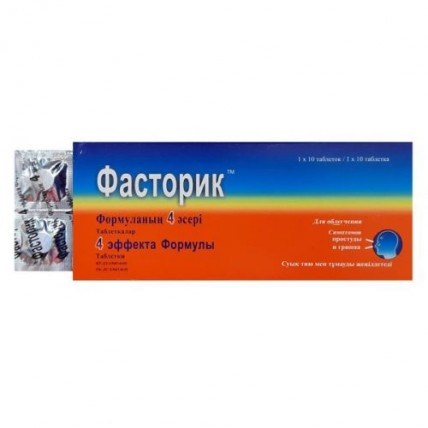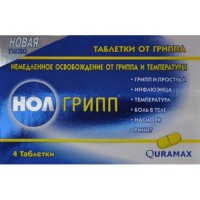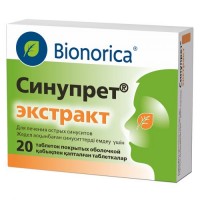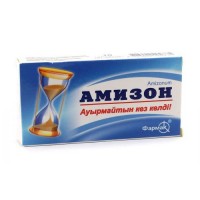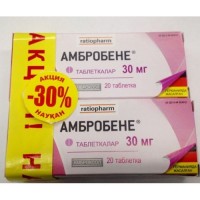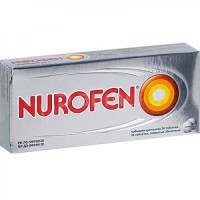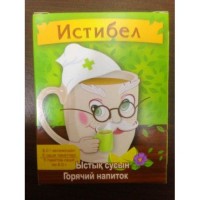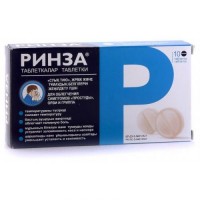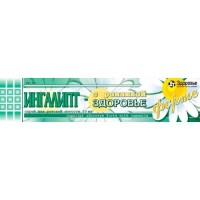The instruction for medical use
of Фасторик™ 4 medicine of effect of the Formula
the Trade name
Фасторик™ 4 effects of the Formula
the International unlicensed name
Is not present
the Dosage form
of the Tablet Structure One Tablet contains
active agents – paracetamol of 500 mg,
chlorpheniramine a maleate of 4 mg,
Phenylephrinum a hydrochloride of 5 mg,
caffeine (anhydrous) 30 mg,
excipients: peptized starch, monohydrate of lactose, starch sodium glycollate, iron oxide red, povidone, purified water, croscarmellose sodium, colloidal dioxide of silicone, the purified talc, magnesium stearate.
The description
the Tablet round, flat, light pink color, unevenly painted, with the dividing line on one party.
The pharmacotherapeutic
Paracetamol group in a combination with other drugs (excepting psikholeptik).
ATC N02BE51 code
the Pharmacological
Pharmacokinetics Paracetamol properties is quickly soaked up from digestive tract with the advent of peak plasma concentration within 10-60 minutes after administration of drug inside. Paracetamol is distributed almost on all body tissues. It passes through a placenta and it is found in breast milk. At usual therapeutic concentration the linking with proteins of blood plasma is insignificant, but at increase in concentration the linking with proteins of blood plasma increases. Elimination half-life of paracetamol varies from 1 to 3 hours. Paracetamol is metabolized generally in a liver and removed with urine mainly in the form of a glucuronide and connections with sulfur. Less than 5% of paracetamol are removed in not changed look.
Chlorpheniramine the maleate is rather slowly absorbed in digestive tract, peak plasma concentration make 2.5 - 6 hours after oral administration. Bioequivalence – 25 - 50%. Chlorfeniramin is exposed to considerable metabolism on the first passing. About 70% of chlorpheniramine contact blood plasma proteins. It is widely distributed on all organism, gets into the central nervous system. Chlorpheniramine the maleate is quickly metabolized. Metabolites include dismetil- and didismetilkhlorfeniramin. Chlorpheniramine the maleate in an invariable look and in the form of metabolites is generally removed with urine. Only a small amount is distinguished with excrements. Intensive absorption and short elimination half-life are observed at children.
Phenylephrinum has the low level of bioequivalence because of non-constant absorption, metabolism of the first passing of monoamine oxidase in an intestinal path and a liver.
Caffeine is almost completely metabolized in a liver by means of oxidation, dimethylation and acetylation and removed with urine in the form of metabolites. Elimination half-life makes from 3 to 7 hours at adults.
The pharmacodynamics
Fastorik 4 effects of a formula is analgetic-antipyretic with weak anti-inflammatory action. Causes an analgesia by increase in a threshold of painful sensitivity and febrifugal effect by influence on the center of thermal control in a hypothalamus. Provides fast effect at the increased temperature, insignificant pains.
Also drug is a competitive antagonist of a histamine, blocking H1 receptors and eliminating, caused by a histamine, a spasm of smooth muscles of digestive tract and bronchial tubes. Drug gets into a brain and has the stimulating or sedative effect.
Besides, drug has sympathomimetic properties with primary direct action on adrenergic receptors. It is characterized by mainly alpha and adrenergic activity without the considerable stimulating effect on the central nervous system in usual doses. In comparison with noradrenaline its pressor action is weaker, but is more long. It causes narrowing of peripheral vessels and increases arterial blood pressure, reduces inflow of blood to skin and kidneys.
Caffeine which is methylxanthine and suppresses enzyme phosphodiesterase is a part of drug, blocks the central adenosine receptors, thereby, having the stimulating effect on the central nervous system.
Indications
- relief of symptoms of cold and flu, such as the increased temperature, cold, congestion of a nose, headache.
The route of administration and doses
to Adults and children are more senior than 12 years: On 1-2 tablets 3-4 times a day.
Maximum single dose: 1 tablet.
Maximum daily dose: 6 tablets.
Side effects
- anorexia, vomiting, constipations, diarrhea, spasms in an abdominal cavity
- thrombocytopenia, a leukopenia, a pancytopenia, a neutropenia, an agranulocytosis
- urticaria, rash
- hepatotoxicity
- drowsiness, headaches, excitability, a general malaise, nervousness,
dizziness, insomnia,
- pharyngitis, discharge of a viscous phlegm
- an ischuria, a polyuria
- an arthralgia, a myasthenia
- a disorder of vision (diplopia)
- reflex bradycardia, arrhythmia, heartbeat
of the Contraindication
- hypersensitivity to drug components
- closed-angle glaucoma, epilepsy, focal
brain damages
- bronchial asthma
- the patients accepting MAO inhibitors
- coronary heart disease, unstable stenocardia,
a myocardial infarction, disturbances of a rhythm
- a serious illness of a liver
- a prostatauxe
- pregnancy, the lactation period
- children's age up to 12 years
Medicinal interaction
the Medicines causing development of a specific microsomal isoenzyme responsible for metabolic activation of acetaminophen (paracetamol) can enhance toxic effect on a liver.
Co-administration with a zidovudine can weaken action of a zidovudine. Co-administration with holestiraminy reduces paracetamol absorption.
Co-administration of a domperidon and Metoclopramidum increases paracetamol absorption.
MAO inhibitors can enhance antimuskarinovy effect of antihistamines therefore antihistamines render additional antimuskarinovy effect when assigning with other antimuskarinovy drugs, such as atropine and tricyclic antidepressants.
Sedation on the central nervous system at prescription of antidepressants, including barbiturates, somnolent, narcotic analgetics, sedative drugs and tranquilizers can be enhanced.
The patients accepting tricyclic antidepressants should avoid administration of drug Fastorik 4 effects of a formula.
Caffeine is exposed to extensive metabolism by means of a microsomal isoenzyme P 450 cytochrome (the RMS 450) and interacts with many medicines and chemicals that raises or reduces metabolic clearance.
Caffeine neutralizes effect of diazepam that causes disturbance of informative skills and relaxation of external eye muscles.
Caffeine neutralizes somnolent effect of phenobarbital.
Cimetidinum and Disulfiramum reduce plasma clearance of caffeine.
At in common reception of oral contraceptives the clearance of caffeine decreases, and elimination half-life raises.
Other types of interactions (with tobacco, alcohol, nutritional supplements):
Chronic alcohol intake in large numbers strengthens paracetamol hepatotoxicity.
Special instructions
to Patients with a renal and liver failure
At patients with a moderate renal failure and dialysis raise plasma concentration of paracetamol and its compound glucuronides and sulfates.
It is necessary to use with care drug to patients with a liver failure.
Influence of drug on driving by transport and control of potentially dangerous mechanisms:
It is not necessary to run motor transport and other dangerous mechanisms during administration of drug.
Overdose
Symptoms: drowsiness, insomnia, headaches, dizziness, excitability, nervousness, a general malaise, hallucinations, a muscular tremor, expansion of pupils, the increased sweating, an ataxy, a coma, face reddening, the increased temperature, a polyuria, a pollakiuria, spasms, reflex bradycardia, tachycardia, arrhythmia, lowering / or increase in arterial blood pressure, necrosis of hepatocytes and renal tubules, nausea, vomiting, dryness in a mouth, a hypoglycemic coma, a metabolic acidosis, a ketosis, a hyperglycemia, thrombocytopenia, a leukopenia, a pancytopenia, a neutropenia, an agranulocytosis.
Treatment: at accidental overdose it is necessary to carry out symptomatic and maintenance therapy.
A form of release and packing
of Tablet No. 4 4 of a tablet in a strip, 1 strip with the instruction for use in cardboard packing.
Tablets No. 10 10 of tablets in a strip, 1 strip with the instruction for use in cardboard packing.
Tablets No. 100 25 of tablets in a strip, 4 strips with the instruction for use in cardboard packing.
To Store storage conditions in the dry place at a temperature not higher than + 250C
to Protect from direct sunshine
to Store out of children's reach!
3 years
not to apply a period of storage after an expiration date.
Prescription status
Without prescription
Plethico Pharmaceuticals Ltd/Pletkhiko Pharmasyyutikalz Ltd Adres Producer of location:
A.B. the Road, Mangliya - 453,771, Indore (L. S.), India
the Legal address:
37/37A, Indastrial Isteyt, Polograund, Indore (L. S.), 452,015, India
to Develop
of Фасторик™ 4 medicine of effect of the Formula
the Trade name
Фасторик™ 4 effects of the Formula
the International unlicensed name
Is not present
the Dosage form
of the Tablet Structure One Tablet contains
active agents – paracetamol of 500 mg,
chlorpheniramine a maleate of 4 mg,
Phenylephrinum a hydrochloride of 5 mg,
caffeine (anhydrous) 30 mg,
excipients: peptized starch, monohydrate of lactose, starch sodium glycollate, iron oxide red, povidone, purified water, croscarmellose sodium, colloidal dioxide of silicone, the purified talc, magnesium stearate.
The description
the Tablet round, flat, light pink color, unevenly painted, with the dividing line on one party.
The pharmacotherapeutic
Paracetamol group in a combination with other drugs (excepting psikholeptik).
ATC N02BE51 code
the Pharmacological
Pharmacokinetics Paracetamol properties is quickly soaked up from digestive tract with the advent of peak plasma concentration within 10-60 minutes after administration of drug inside. Paracetamol is distributed almost on all body tissues. It passes through a placenta and it is found in breast milk. At usual therapeutic concentration the linking with proteins of blood plasma is insignificant, but at increase in concentration the linking with proteins of blood plasma increases. Elimination half-life of paracetamol varies from 1 to 3 hours. Paracetamol is metabolized generally in a liver and removed with urine mainly in the form of a glucuronide and connections with sulfur. Less than 5% of paracetamol are removed in not changed look.
Chlorpheniramine the maleate is rather slowly absorbed in digestive tract, peak plasma concentration make 2.5 - 6 hours after oral administration. Bioequivalence – 25 - 50%. Chlorfeniramin is exposed to considerable metabolism on the first passing. About 70% of chlorpheniramine contact blood plasma proteins. It is widely distributed on all organism, gets into the central nervous system. Chlorpheniramine the maleate is quickly metabolized. Metabolites include dismetil- and didismetilkhlorfeniramin. Chlorpheniramine the maleate in an invariable look and in the form of metabolites is generally removed with urine. Only a small amount is distinguished with excrements. Intensive absorption and short elimination half-life are observed at children.
Phenylephrinum has the low level of bioequivalence because of non-constant absorption, metabolism of the first passing of monoamine oxidase in an intestinal path and a liver.
Caffeine is almost completely metabolized in a liver by means of oxidation, dimethylation and acetylation and removed with urine in the form of metabolites. Elimination half-life makes from 3 to 7 hours at adults.
The pharmacodynamics
Fastorik 4 effects of a formula is analgetic-antipyretic with weak anti-inflammatory action. Causes an analgesia by increase in a threshold of painful sensitivity and febrifugal effect by influence on the center of thermal control in a hypothalamus. Provides fast effect at the increased temperature, insignificant pains.
Also drug is a competitive antagonist of a histamine, blocking H1 receptors and eliminating, caused by a histamine, a spasm of smooth muscles of digestive tract and bronchial tubes. Drug gets into a brain and has the stimulating or sedative effect.
Besides, drug has sympathomimetic properties with primary direct action on adrenergic receptors. It is characterized by mainly alpha and adrenergic activity without the considerable stimulating effect on the central nervous system in usual doses. In comparison with noradrenaline its pressor action is weaker, but is more long. It causes narrowing of peripheral vessels and increases arterial blood pressure, reduces inflow of blood to skin and kidneys.
Caffeine which is methylxanthine and suppresses enzyme phosphodiesterase is a part of drug, blocks the central adenosine receptors, thereby, having the stimulating effect on the central nervous system.
Indications
- relief of symptoms of cold and flu, such as the increased temperature, cold, congestion of a nose, headache.
The route of administration and doses
to Adults and children are more senior than 12 years: On 1-2 tablets 3-4 times a day.
Maximum single dose: 1 tablet.
Maximum daily dose: 6 tablets.
Side effects
- anorexia, vomiting, constipations, diarrhea, spasms in an abdominal cavity
- thrombocytopenia, a leukopenia, a pancytopenia, a neutropenia, an agranulocytosis
- urticaria, rash
- hepatotoxicity
- drowsiness, headaches, excitability, a general malaise, nervousness,
dizziness, insomnia,
- pharyngitis, discharge of a viscous phlegm
- an ischuria, a polyuria
- an arthralgia, a myasthenia
- a disorder of vision (diplopia)
- reflex bradycardia, arrhythmia, heartbeat
of the Contraindication
- hypersensitivity to drug components
- closed-angle glaucoma, epilepsy, focal
brain damages
- bronchial asthma
- the patients accepting MAO inhibitors
- coronary heart disease, unstable stenocardia,
a myocardial infarction, disturbances of a rhythm
- a serious illness of a liver
- a prostatauxe
- pregnancy, the lactation period
- children's age up to 12 years
Medicinal interaction
the Medicines causing development of a specific microsomal isoenzyme responsible for metabolic activation of acetaminophen (paracetamol) can enhance toxic effect on a liver.
Co-administration with a zidovudine can weaken action of a zidovudine. Co-administration with holestiraminy reduces paracetamol absorption.
Co-administration of a domperidon and Metoclopramidum increases paracetamol absorption.
MAO inhibitors can enhance antimuskarinovy effect of antihistamines therefore antihistamines render additional antimuskarinovy effect when assigning with other antimuskarinovy drugs, such as atropine and tricyclic antidepressants.
Sedation on the central nervous system at prescription of antidepressants, including barbiturates, somnolent, narcotic analgetics, sedative drugs and tranquilizers can be enhanced.
The patients accepting tricyclic antidepressants should avoid administration of drug Fastorik 4 effects of a formula.
Caffeine is exposed to extensive metabolism by means of a microsomal isoenzyme P 450 cytochrome (the RMS 450) and interacts with many medicines and chemicals that raises or reduces metabolic clearance.
Caffeine neutralizes effect of diazepam that causes disturbance of informative skills and relaxation of external eye muscles.
Caffeine neutralizes somnolent effect of phenobarbital.
Cimetidinum and Disulfiramum reduce plasma clearance of caffeine.
At in common reception of oral contraceptives the clearance of caffeine decreases, and elimination half-life raises.
Other types of interactions (with tobacco, alcohol, nutritional supplements):
Chronic alcohol intake in large numbers strengthens paracetamol hepatotoxicity.
Special instructions
to Patients with a renal and liver failure
At patients with a moderate renal failure and dialysis raise plasma concentration of paracetamol and its compound glucuronides and sulfates.
It is necessary to use with care drug to patients with a liver failure.
Influence of drug on driving by transport and control of potentially dangerous mechanisms:
It is not necessary to run motor transport and other dangerous mechanisms during administration of drug.
Overdose
Symptoms: drowsiness, insomnia, headaches, dizziness, excitability, nervousness, a general malaise, hallucinations, a muscular tremor, expansion of pupils, the increased sweating, an ataxy, a coma, face reddening, the increased temperature, a polyuria, a pollakiuria, spasms, reflex bradycardia, tachycardia, arrhythmia, lowering / or increase in arterial blood pressure, necrosis of hepatocytes and renal tubules, nausea, vomiting, dryness in a mouth, a hypoglycemic coma, a metabolic acidosis, a ketosis, a hyperglycemia, thrombocytopenia, a leukopenia, a pancytopenia, a neutropenia, an agranulocytosis.
Treatment: at accidental overdose it is necessary to carry out symptomatic and maintenance therapy.
A form of release and packing
of Tablet No. 4 4 of a tablet in a strip, 1 strip with the instruction for use in cardboard packing.
Tablets No. 10 10 of tablets in a strip, 1 strip with the instruction for use in cardboard packing.
Tablets No. 100 25 of tablets in a strip, 4 strips with the instruction for use in cardboard packing.
To Store storage conditions in the dry place at a temperature not higher than + 250C
to Protect from direct sunshine
to Store out of children's reach!
3 years
not to apply a period of storage after an expiration date.
Prescription status
Without prescription
Plethico Pharmaceuticals Ltd/Pletkhiko Pharmasyyutikalz Ltd Adres Producer of location:
A.B. the Road, Mangliya - 453,771, Indore (L. S.), India
the Legal address:
37/37A, Indastrial Isteyt, Polograund, Indore (L. S.), 452,015, India
to Develop
